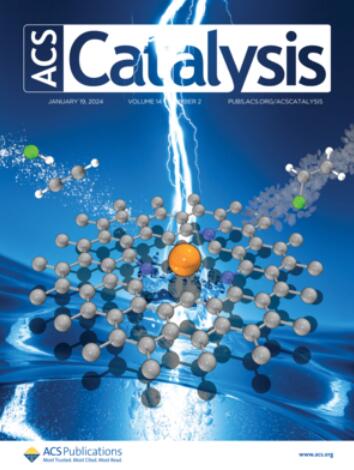用计算与实验相结合的方法评估MFI沸石中孔隙环境对丙烯寡聚动力学的影响
IF 11.3
1区 化学
Q1 CHEMISTRY, PHYSICAL
引用次数: 0
摘要
研究了MFI分子筛中Brønsted酸位对丙烯低聚反应的影响。MFI中的吸附剂可能位于较小的通道(~ 5.5 Å直径)或较大的通道交叉处(~ 7 Å直径),更严格的限制有望增强稳定色散相互作用和不稳定的空间约束。以四丙基铵(TPA+)为结构导向剂合成的MFI样品在交叉点附近的酸位点比例较高,而以1,4-重氮杂环[2.2.2]辛烷(DABCO)或乙二胺(EDA)合成的样品在通道内的酸位点比例较高。测定的丙烯二聚率(每H+, 315 kPa C3H6, 503 K, 1.6 H+/u.c)在MFI-DABCO/MFI-EDA上比MFI-TPA高9倍。由于在这些条件下,在MFI中丙烯的低聚化受到传输限制,因此实验测量的速率与有效动力学(keff)和扩散(De)常数成正比。因此,在不考虑输运效应的情况下,利用离散傅里叶变换来研究空隙环境对动力学的影响。计算了MFI框架中所有12个t位点和每个t位点周围所有可达的o位点对C3和C6烯烃的吸附自由能和二聚化自由能垒。在所有的孔道环境中,C3优先吸附为h键丙烯,具有相似的能量,而C6烯烃在相对于交叉点的孔道中平均失稳10-56 kJ mol-1,二聚化过渡态平均失稳29-102 kJ mol-1。C3和C6烯烃的稳定性和二聚化过渡态在很大程度上是由MFI框架畸变引起的空间惩罚所控制的,这种惩罚超过了随着空隙尺寸减小而产生的更强的色散相互作用,即使对于像C3这样小的物种也是如此。鉴于DFT预测的keff值在MFI的较小通道空隙中的酸性位点较低,使用DABCO或EDA合成的MFI样品的较高测量率必须反映较少的严重扩散限制,进而反映较高的De值。本文章由计算机程序翻译,如有差异,请以英文原文为准。

Assessing the Influence of Void Environment in MFI Zeolites on Propene Oligomerization Kinetics Using a Combined Computational and Experimental Approach
The consequences of Brønsted acid site location in MFI zeolites were investigated for propene oligomerization. Adsorbates in MFI may reside in smaller channels (∼5.5 Å diam.) or larger channel intersections (∼7 Å diam.), with tighter confinement expected to enhance both stabilizing dispersive interactions and destabilizing steric constraints. MFI samples synthesized using tetrapropylammonium (TPA+) as the structure directing agent have higher fractions of acid sites near intersections, while samples synthesized with 1,4-diazabicyclo[2.2.2]octane (DABCO) or ethylenediamine (EDA) have higher fractions of acid sites within channels. Measured propene dimerization rates (per H+, 315 kPa C3H6, 503 K, 1.6 H+/u.c.) are ∼9 times higher on MFI-DABCO/MFI-EDA than MFI-TPA. Because propene oligomerization is transport-limited in MFI at these conditions, experimentally measured rates are proportional to both effective kinetic (keff) and diffusion (De) constants. DFT was therefore used to investigate the kinetic influences of void environment in isolation of transport effects. Adsorption free energies for C3 and C6 alkenes and dimerization free energy barriers were calculated at all 12 T-sites present in the MFI framework and all accessible O-sites around each T-site. C3 preferentially adsorbs as H-bonded propene with similar energies in all void environments, while C6 alkenes are destabilized by 10–56 kJ mol–1 and dimerization transition states are destabilized by 29–102 kJ mol–1, on average, in the channels relative to intersections. The stability of C3 and C6 alkenes and dimerization transition states is largely governed by steric penalties arising from distortion of the MFI framework that outweigh stronger dispersive interactions with decreasing void size, even for species as small as C3. Given that DFT predicts keff values are lower at acid sites in smaller channel voids of MFI, higher measured rates on MFI samples synthesized using DABCO or EDA must reflect less severe diffusion restrictions and, in turn, higher De values.
求助全文
通过发布文献求助,成功后即可免费获取论文全文。
去求助
来源期刊

ACS Catalysis
CHEMISTRY, PHYSICAL-
CiteScore
20.80
自引率
6.20%
发文量
1253
审稿时长
1.5 months
期刊介绍:
ACS Catalysis is an esteemed journal that publishes original research in the fields of heterogeneous catalysis, molecular catalysis, and biocatalysis. It offers broad coverage across diverse areas such as life sciences, organometallics and synthesis, photochemistry and electrochemistry, drug discovery and synthesis, materials science, environmental protection, polymer discovery and synthesis, and energy and fuels.
The scope of the journal is to showcase innovative work in various aspects of catalysis. This includes new reactions and novel synthetic approaches utilizing known catalysts, the discovery or modification of new catalysts, elucidation of catalytic mechanisms through cutting-edge investigations, practical enhancements of existing processes, as well as conceptual advances in the field. Contributions to ACS Catalysis can encompass both experimental and theoretical research focused on catalytic molecules, macromolecules, and materials that exhibit catalytic turnover.
 求助内容:
求助内容: 应助结果提醒方式:
应助结果提醒方式:


